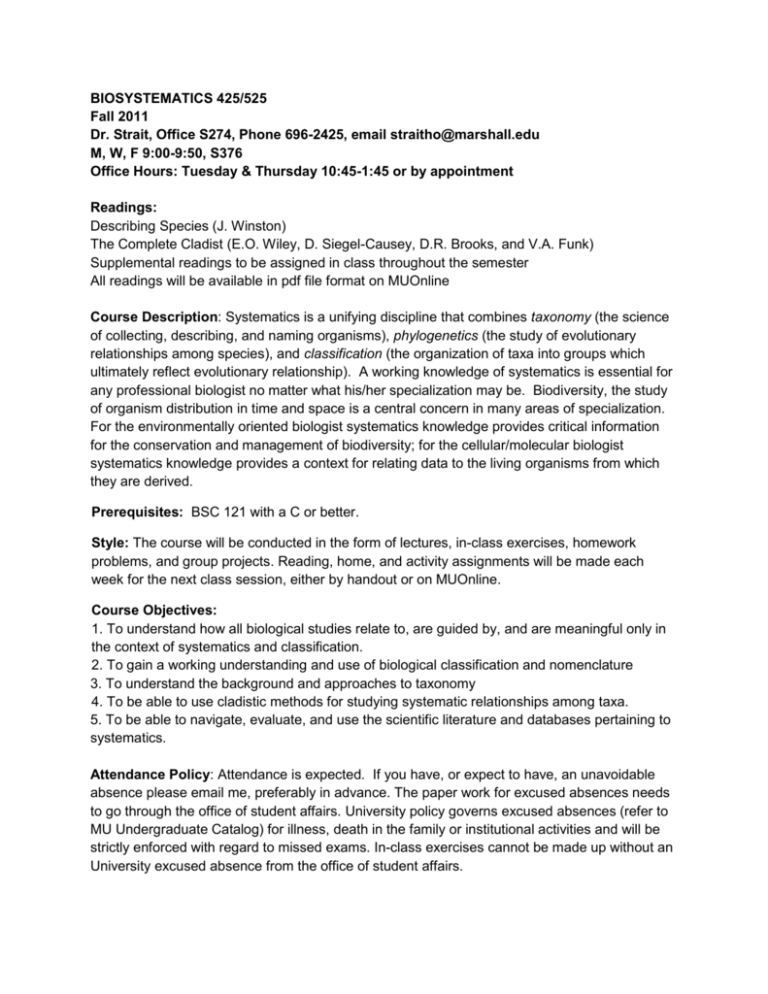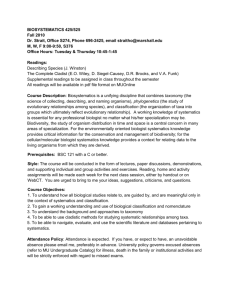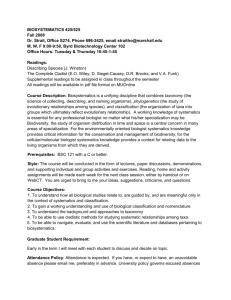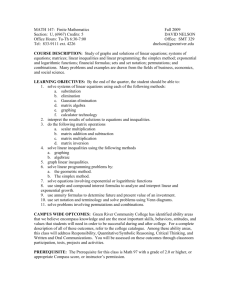BIOSYSTEMATICS 425/525 Fall 2011 Dr. Strait, Office S274, Phone
advertisement

BIOSYSTEMATICS 425/525 Fall 2011 Dr. Strait, Office S274, Phone 696-2425, email straitho@marshall.edu M, W, F 9:00-9:50, S376 Office Hours: Tuesday & Thursday 10:45-1:45 or by appointment Readings: Describing Species (J. Winston) The Complete Cladist (E.O. Wiley, D. Siegel-Causey, D.R. Brooks, and V.A. Funk) Supplemental readings to be assigned in class throughout the semester All readings will be available in pdf file format on MUOnline Course Description: Systematics is a unifying discipline that combines taxonomy (the science of collecting, describing, and naming organisms), phylogenetics (the study of evolutionary relationships among species), and classification (the organization of taxa into groups which ultimately reflect evolutionary relationship). A working knowledge of systematics is essential for any professional biologist no matter what his/her specialization may be. Biodiversity, the study of organism distribution in time and space is a central concern in many areas of specialization. For the environmentally oriented biologist systematics knowledge provides critical information for the conservation and management of biodiversity; for the cellular/molecular biologist systematics knowledge provides a context for relating data to the living organisms from which they are derived. Prerequisites: BSC 121 with a C or better. Style: The course will be conducted in the form of lectures, in-class exercises, homework problems, and group projects. Reading, home, and activity assignments will be made each week for the next class session, either by handout or on MUOnline. Course Objectives: 1. To understand how all biological studies relate to, are guided by, and are meaningful only in the context of systematics and classification. 2. To gain a working understanding and use of biological classification and nomenclature 3. To understand the background and approaches to taxonomy 4. To be able to use cladistic methods for studying systematic relationships among taxa. 5. To be able to navigate, evaluate, and use the scientific literature and databases pertaining to systematics. Attendance Policy: Attendance is expected. If you have, or expect to have, an unavoidable absence please email me, preferably in advance. The paper work for excused absences needs to go through the office of student affairs. University policy governs excused absences (refer to MU Undergraduate Catalog) for illness, death in the family or institutional activities and will be strictly enforced with regard to missed exams. In-class exercises cannot be made up without an University excused absence from the office of student affairs. Academic dishonesty: Academic dishonesty in any form will not be tolerated. Unless assigned as a group activity all written assignments and exams are to be independent efforts of each student. Electronic Devices: All electronic devices that make noise must be silenced during class. I can’t text or play Words with Friends during class so you can’t either Grading: Course grades for will be based on exams (50%), homework assignments and in-class exercises (25%), and class projects (25%). The scale is: 90 -100 %, A; 80 - 90%, B; 70 - 80%, C; 60 - 70%, D. Homework assignments: All homework must be typed, double spaced, 10-12 point font, and be 2-3 pages in length (unless otherwise announced). All homework assignments are due at the time of the class meeting within one week of their announcement (so if the assignment was made on a Monday it is due the following Monday) (late papers will incur a 5 point per day deductions). In-class assignments: Although this class has no formal lab time, it is necessary to do lab-related activities to properly learn the material. Therefore, some class periods will be devoted to hands-on exercises. Although most of the assignments should be completed in-class further work on them may be required. All in-class assignments must be completed (and typed unless otherwise stated) and turned in prior to the following class meeting unless otherwise specifically stated (late papers will incur a 5 point per day deductions). Class projects: I am currently developing a web site for the general public to educate people about the biodiversity of West Virginia. Your class project will contribute to this bigger project and, if the quality of your work is there, it will be published on this web site. Specifically, our class project will be making on-line interactive taxonomic keys for all the mammal species that live in West Virginia. The goal is to make very visual user-friendly keys that can be used to anyone to identify any of the state’s mammals. Each student will be assigned individual species they are responsible for (2-3 each) and you will work in groups to integrate your keys with others in the class. These projects will be presented to the class during the last 2 class meetings. Exams: (1) Two unit exams over class material (lectures, reading, homework, etc...) will be given. These exams will include a combination of multiple choice, fill-in the blank, short answer questions, definitions, true/false, and/or problems. (2) Final Exam (not cumulative): definitions, short answer, and problems. Date: 8/22 Topic: Class Introduction Reading: 8/24 Work on assignment (Homework #1 –Web-based key site search) 8/26 Work on assignment (Homework #1 – due 8/31) 8/29 Lecture #1: West Virginia Mammal overview for projects Taxonomic keys Winston Ch. 19 8/31 Student presentations of Web sites and discussion of class projects 9/2 In-class exercise #1 – Taxonomic keys 9/5 No Class Labor Day 9/7 Lecture #2: Biodiversity and taxonomy Homework assignment #2 – New species 9/9 Lecture #3: Biological nomenclature Winston Ch. 2 Homework assignment #3 –Classification and nomenclature of your project species 9/12 In-class exercise #2- Biological nomenclature: Taxonomy and nomenclature of office supplies 9/14 Class project discussion Lecture #4: Species, sub species and their discovery Winston Ch. 3, 17 Futuyma, 1998 Ch. 9 (253-263) 9/16 Scorpion Taxonomy (Guest Lecture - Dr. Victor Fet) Homework assignment #4 on scorpion taxonomy 9/19 Lecture #5: Taxonomic literature and museum collections Winston Ch. 4-5 Homework assignment #5 – Internet museum search 9/21 Museum/herbaria tour 9/23 In-class exercise #3 - Museum studies 9/26 In-class exercise #3 - Museum studies 9/28 Exam 1 Winston Ch. 1 Fet, 2002 9/30 Lecture #6: Species Descriptions Winston Ch. 6-9 10/3 Lecture #7: Species Descriptions Winston Ch. 10-15 10/5 Exam review, homework assignment #6 (Species descriptions) and project discussion 10/7 Lecture #9: History of Systematics 10/10 Lecture #10: Cladistics Intro Part 1 Wiley et al. Ch. 1 10/12 Lecture #11:Cladistics Intro Part 2 Wiley et al. Ch. 2 10/14 In-class exercise #4 – Basic cladistics review 10/17 Lecture #12: Cladistics (Terms and Concepts) 10/19 In-class exercise #5 – Monophyly and cladogram characters 10/21 Exam II 10/24 Lecture #13: Cladistics (Basic Techniques) 10/26 Review exam In-class exercise #6 – Inclusion/exclusion rule 10/28 Class Project Group Meetings Written version of key due 10/31 Lecture #14 Cladistics (Resolving Conflict & Tree Length) In-class exercise #7 – Tree length 11/2 Lecture #15: Cladistics (Coding Characters) In-class exercise #8 - Camincules 11/4 In-class exercise #9 – Tree length and CI 11/7 Class Project Group Meetings 11/9 Class Project Group Meetings 11/11 Class Project Group Meetings Futuyma, 1998 Ch. 5 (87-108) Wiley et al. Ch. 3 11/14 Lecture #16: Cladistics (Character Polarity) First draft of group projects done (visual key draft done) 11/16 In-class exercise #10 – Polarity exercise 11/18 Lecture #17: Cladistics (Reversals) 11/21-11/25 No Class Thanksgiving Break 11/28 Lecture #18: Cladistics (Parsimony algorithms and consensus trees) Wiley et al., Ch. 5 11/30 In-class exercise #11 – Consensus trees 12/2 Class project presentations 12/5 Class project presentations Final: Friday December 9, 8:00-10:00 Wiley et al. Ch. 4









